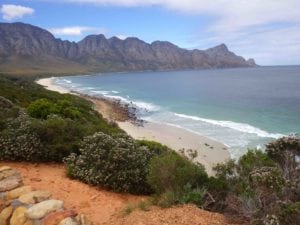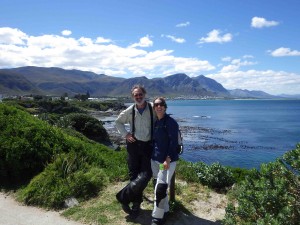Whales have mystified and captivated humans for as long as the two mammals have shared the earth. The whale’s large size the fact that little of their lives could be seen lent them to being misunderstood and created a certain mystique. Many cultures hold them in awe, even featuring them in their mythologies.
The tip of South Africa, where two of the world’s greatest oceans converge, remains one of the best places on earth to catch a glimpse of these magnificent denizens of the deep. Migrating whales crowd the sea lanes here from July to November each year. Often only metres from shore, sightings are captivating, exhilarating, and awesome.

Chapman’s Peak Drive
One of the best places to see them is along the 65 kilometre greater Mossel Bay coastline section of the 1,200 mile Whale Route from Cape Town to Durban. While 37 species of whales and dolphins inhabit these waters at some time of year, the most common are Southern Right Whales, so named because their slow speed and carcasses that float make them the “right” whale to hunt. After gorging on krill in the Antarctic, they migrate north into Mossel Bay to calve, nurse their young, and mate.

Humpback whales, which can weigh up to 30 tons, migrate along the coast en-route to their feeding and breeding grounds off Mozambique and Angola. Bryde’s and Killer whales are also frequently seen here.
Self-proclaimed as the whale-watching capital of the world, the small town of Hermanus is a magnet for whales. Cliff edges plunge into waters deep enough for whales to frolic. The warm water in sheltered coves and bays is ideal for birthing. Strolling along the seven-mile coastal walkway provides spectacular views, and can eave you damp from whales breaching mere metres away.

Characteristic Whale Behaviors:
Breaching
Whales leap out of the water and twirl around before falling back, creating a tremendous splash. It’s done for play, to loosen irritations on the skin, or to get an aerial view of the surroundings.
Fluking or Sailing
Flukes are the two lobes of the whale tail. Fluking, refers to the whale’s act of raising its tail out of the water at the beginning of a dive.
Lob-tailing
Thought to be a means of communication between whales, it occurs when the whale sticks its tail out of the water and repeatedly slaps it onto the water’s surface.
Blowing
Also known as spouting, it produces a plume of misty water out of the blowhole on top of the whale’s head. Southern Right Whales have two blowholes, creating a V-shaped plume.
Logging
This occurs when whales float on the water, making no attempt to move.
Spyhopping
The whale rises and holds its position partially out of the water. The eyes are at or just below water level to enable it to have a good look around.
Whale-watch from safaris or excursions that include Cape Town and the southern coast. Victoria Falls to Cape Town, Spectacular South West Africa, or the The Garden Route.
Photo Credits: Evan and Liza Firstman

